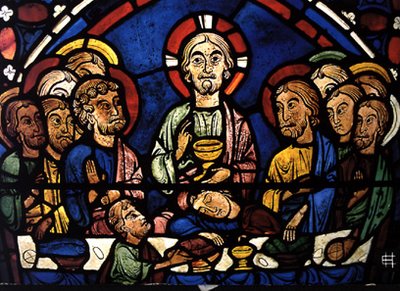
The test on Monday will cover the early, high and late middle ages. That means chapters 9, 10 and 11, with the EXCEPTION of the following sections:
Chapter 9:
Monasticism and Gregorian Chant
Liturgical Music and the Rise of Drama
The Morality Play
The Legend of Charlemagne: Song of Roland
Chapter 10:
Music: The school of Notre Dame
Dante's Divine Commedy
Chapter 11:
Literature in Italy, England and France
Music: Ars Nova
Define:
ambulatory
mendicant
lancet
archivolt
tympanum
flying buttress (also called "flying arch")
horarium
scriptorium
Seven Liberal Arts
trivium
quadrivium
dialectic
Scholasticism
Sic et Non
“Credo ut Intellegam”
hierarchy
Rule of St. Benedict
Carolingian miniscule
"Gothic"
Lectio Divina
"mysticism of light"
narthex
nave
pilgrimage church
relics
Black Death
Hundred Year’s War
Great Schism
Nominalism
“Devotio Moderna”
Giotto
Duccio
International Gothic Style
duomo
perpendicular
Explain who or what these are, and why they are important:
Charlemagne
Alcuin
Saint Sernin, Toulouse Church (be able to identify)
Chartres Cathedral (Be able to identify)
Beauvais Cathedral
Milan Cathedral (Duomo, Milan) (Be able to identify)
Palace at Aachen (be able to identify)
Paris (the city of)
University of Paris
Abbot Suger
St. Benedict of Nursia
St. Francis of Assisi
St. Thomas Aquinas
Dominicans
Franciscans
Benedictines
Rule of St. Benedict
Scholasticism
Dagulf Psalter (identify)
Summa Theologiae
Wilton Diptych (identify)
Tres Riches Heures du Duc de Berry (identify)
Discuss:
(refer to readings and power point presentations)
· How did Charlemagne and Alcuin foster literacy and learning?
· Identify and discuss the Utrecht psalter, the Dagulf Psalter and the Gospel book of Charlemagne
· Who were the important philosophers of the early and high middle ages, and what were some of their ideas?
· What is meant by Scholasticism?
· Discuss the Romanesque style. How does it reflect Benedictine traditions? Discuss some specific Romanesque buildings.
· Discuss the Gothic style How does it reflect Scholasticism? Discuss some specific Gothic cathedrals.
· Compare and contrast Romanesque and Gothic architecture.
· What is meant by “the mysticism of light?” Give examples.
· What is meant by the term “gothic?”
· What three factors made the 14th century a “time of transition?” What effect did they have on the way people of the late middle ages thought and valued? How did this play out in the art and architecture of the time?
· Are there any similarities between the world of the 14th century and ours today? Explain.
· Explain how the Black Death, the Great Schism, and the Hundred Years’ war changed European culture
· Explain the importance of these cities: Paris, Siena
· Why is Giotto important? What is meant by his "break with the past?"What are the important themes of the Middle Ages? Discuss in detail.
· Explain, and give examples of how the medievals understood life as a pilgrimage.
· Explain and discuss the "both-and" worldview of the middle ages.
· What was the impact of Monasticism on the middle ages?
Compare and contrast St. Francis and St. Thomas Aquinas
